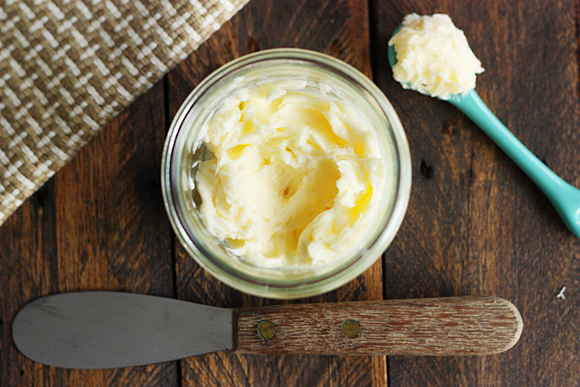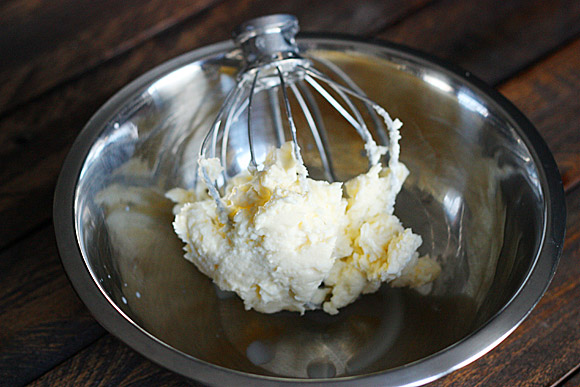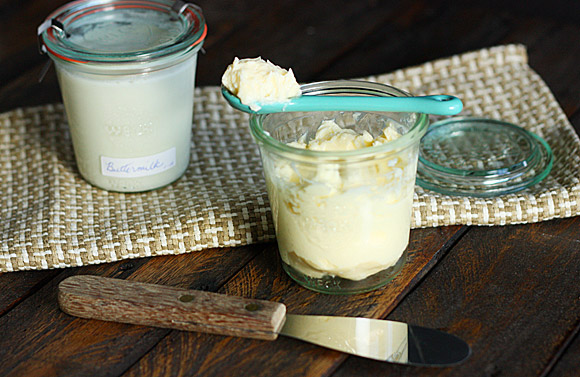
A couple of years back, I wrote a post about making homemade butter. If you’ve never made butter before, you have to try it. Please, do try it. Every accomplished home cook should know how to make butter, even if you do it only once.
The first time I made butter, not only was I completely gobsmacked by the delicious result, but I also felt oddly self-sufficient and pilgramy, like I had just stepped into another time, unlocking a lost but fabulous cooking secret.
Butter has one simple ingredient (cream) and, while a stand mixer is easiest, you really don’t need special equipment (large glass jar with a leakproof lid, and the willingness to shake-shake-shake for about 10 minutes straight will get the job done).
But I’ve been holding out on you. Homemade butter is really only half the story. The rest is all about … fermentation.
Fermented cream, to be exact. Now, please don’t hit the Back button, or unsubscribe from my email list, or anything rash like that. Just sit back and take a deep breath. It isn’t gross, I promise.
And the reward is butter like you’ve never had before.
Cultured butter, that is, which is what milk wants to be when it grows up. And this post is a two-in-one: the byproduct of making cultured butter is cultured buttermilk — buttermilk you can drink (if that’s your thing — it ain’t mine, ew) and bake with ([nods] now you’re talkin’).
But first, let’s get a little technical and review the science of milk.
Or, how about *I* get technical and you just relax and take it all in. Okay? Yeah, that’s better.
Milk drawn directly from a cow — this post deals with just cow milk — is drinkable, but controversial. Raw milk contains bacterial microbes, as you would expect. All animals on this planet — and that includes you and me, as well as Bessie over there in yonder pasture — are full of bacterial microbes, some beneficial (such as L. acidophilus, the commonly known probiotic), some not so much (pathogens like salmonella and E. coli). These microbes — good and bad — are secreted in our bodily byproducts, including milk (both human and bovine).
(Mmmmm, bodily byproducts. SoupAddict does have a way with words.)
Pasteurization
Enter pasteurization. Pasteurization — the process of heating something to a temperature that inhibits microbial growth — was developed in the 1700’s, and first applied to milk in the late 1800’s with the groundbreaking intent of extending milk’s shelf-life.
Later, ultra high-temperature (UHT) pasteurization was developed to further extend that shelf-life from mere weeks to months, making long-distance, cross-country transport of milk possible.
Now, without diving into the controversy of raw milk vs. pasteurized, I’ll simply say that the net effect of pasteurization is that beneficial microbes are inhibited or destroyed. And definitively so in UHT pasteurization, which is applied to the vast majority of the milk you’ll find in your grocery store (next time you visit, check the labels – look for “UHT” or “ultra-pasteurized”).
Fermentation
In addition to the many, um, internal benefits humans derive from beneficial microbes — or, to use the food industry’s familiar packaging term, “live cultures” or “active cultures” — these microbes kick off the fermentation process that gives yogurt, sour cream and crème fraîche their wonderful, tangy-smooth flavors. These are cultured products that could not exist without beneficial microbes.
And cheese? No beneficial microbes = no fermentation = no cheese. That’s right, the amazing Parmesano-Reggiano that you carefully grate over your lovingly created meals would not exist without fermentation.
Fermentation is a good thing, not a gross thing.
Butter
Which brings us back around to butter. I’m sure you’ve guessed by now that cultured butter undergoes … say it with me … fermentation. Yes! This process gives butter a rich, just-short-of-tangy flavor that totally kicks regular butter to the curb. If you’ve ever had European butter, you know what I mean — unlike the U.S., butter is almost always cultured in Europe.
Sweet cream butter — the majority of the real butter found in grocery stores — is made from any ole milk, including UHT pasteurized milk. Cultured butter, on the other hand, is beneficial-microbe-enriched milk that’s allowed to ferment for a short period of time before churning into butter.
Think of the flavor difference between sweet cream butter and cultured butter as you would sauteed onions and caramelized onions. Sauteed onions are great, but if you add a little red wine vinegar, a little salt, and let those babies simmer in the pan for a while, you achieve a whole new level of onion goodness.
My lesson on pasteurization, beneficial microbes and fermentation all leads to this: to make cultured butter, you need milk and you need a source of beneficial microbes, which, due to pasteurization, must come from a source other than the milk itself, such as yogurt (raw milk with its beneficial microbes intact can produce cultured butter). (Microbes can also be purchased for purpose of inoculating your pasteurized milk to make cultured milk products, but here yogurt will serve just as well).
Homogenization
Side note for the milk science curious: homogenization is a different process altogether. Raw milk naturally separates into milk solids (hello, cream!) and liquids while resting, requiring a good shaking to mix the two together. Homogenization breaks down milk molecules into smaller bits so that solids don’t clump together, and the milk is always in smooth liquid form. The absence of homogenization is not at all dangerous and has nothing to do with product safety.

Enough science! Let’s get this cultured party started!
First, select your cream. Choose the freshest, least pasteurized cream you can find, which, granted, is quite the challenge. I’m lucky enough to live in the same state as Snowville Creamery, a small dairy that produces minimally pasteurized milk from grass-fed cows. Holy cow [you know I had to go there sooner or later] their stuff is good and makes the best butter, cultured or not. (If you’ve had Jeni’s Splendid ice cream, then you, too, have enjoyed the amazing milk from Snowville — they’re Jeni’s supplier). I hope you are similarly local-dairy fortunate. (If your selection is coming from the grocery store shelf, look for “heavy cream.”)
Next, your yogurt. Read the label: ideally, choose a brand that is made from only milk (and may or may not contain added live cultures, which is fine). Avoid brands with preservatives. Important: make sure the container reads “live cultures” or “active cultures.”
Mix the two together (amounts in the recipe below) in a meticulously cleaned glass or glazed ceramic bowl (no plastic – it’s porous and can harbor pathogens). Cover and leave in a warm spot overnight to ferment and thicken.

Then churn as you would regular butter. During the churning process (I always use my stand mixer), the fermented cream will proceed from liquid to glossy whipped cream to a disturbingly scraggly mess. Keep going. Eventually, the solids break from the liquid. Ta-da! You have butter. (And buttermilk!)
People, you would not believe how silky smooth this stuff is, and so wonderfully fragrant. If you could gather up silk into a solid, balled mass, it would feel like this butter.

And the flavor … [swoon]. Mix in a little salt, and schmear it on homemade scones or multigrain toast. Butter heaven!
Cultured Butter & Cultured Buttermilk
Prep Time: 2 minutes (but requires overnight rest)
Make time: 20 minutes
Yield: about 1 cup of cultured butter, and 1 cup of cultured buttermilk
You can easily scale this recipe up or down. Use twice as much milk as the amount of butter you’re wanting to make, and figure 3 tablespoons of yogurt for every cup of milk.
Ingredients:
2 cups fresh whipping cream/heavy cream (see instructions before measuring)
6 tablespoons yogurt or creme fraiche (make sure the packaging says it contains live cultures)
Finishing salt (like Maldon’s, or gray sea salt) (optional)
Instructions:
Give the carton of cream a good shake. If you’re using unhomogenized milk, give it a really good shake. Measure the cream into a spotlessly clean glass or ceramic-glazed bowl (no porous plastic – it can harbor dangerous pathogens). Peer into the carton, and if you see any creamy solids clinging to the sides, use a long spoon to scrape some into the bowl.
Stir in the yogurt and very gently whisk to incorporate into the milk (gently — you don’t want to start the churning process).
Cover the bowl with a towel or plastic wrap and place in a warm location (60-70°F). Let rest overnight (12 to 18 hours).
The milk mixture will thicken. Give the bowl a gentle shake. The liquid will sway, not slosh or splash, when it’s ready.
Pour the liquid into a mixing bowl (use the whisk attachment on a stand mixer) and whip on medium-low speed for 30 seconds, then increase to medium.*
The milk mixture will proceed through several stages: first, it forms a glossy whipping cream, followed by a thicky, grainy stage. Finally, the butter solids will break from the liquid. There will be clumps of butter and lots of liquid in the bowl. You’ll know it when it happens — stop at this point.
Gather the clumps of solid and move them to another clean bowl (reserve the liquid in the mixing bowl). If you’re going to be using all of the butter at once, you’re finished – enjoy! If you’re going to be storing the butter, or if you want to add salt, go to the next step.
Here’s the fun part. Knead, mash, schmoosh the butter in the bowl so as to strain as much liquid from the solids as possible. Use clean hands or a large, sturdy wooden spoon for this.
Add the liquid from the schmooshing bowl to the liquid in the mixing bowl. This is your cultured buttermilk! Pour into a tightly-sealing bottle or bowl and place in the fridge. Use for drinking or baking.
One final step with the butter: to prolong storage, you must remove as much of the buttermilk as possible. Rinse the butter in cold water and continue kneading. Rinse and knead until the water squeezed from the butter runs clear. If using salt, knead in the salt, then store the butter in a covered dish in the fridge. It also freezes well.
*Note: I use my stand mixer to make butter for one simple reason. When the solids break from the liquids, it happens instantaneously and, to put it bluntly, it’s a volcanic situation: buttermilk will spray everywhere. With a stand mixer, you can cover the bowl to minimize the splatter. I wrap cling wrap around the attachment head and then drape it all around the bowl, taping it down. With double-sided tape. You’ve been warned. 😉


Kim
Thursday 21st of July 2022
I just made fresh butter for the first time, without knowing it could be fermented. I came across this post as I was wondering if I can ferment the buttermilk left from making butter. I'm going to try adding a Tablespoon of whey from my homemade yogurt. The next time I make butter I will try this method. Thank you
Deanna
Friday 22nd of January 2021
I made this butter & buttermilk following your recipe (using ultra pasteurized cream and Chobani vanilla yogurt bc that’s what I had) and it came out wonderfully yummy, slightly sweet. I used the buttermilk to make a banana cake. Thank you for sharing this recipe!!
Jennifer
Sunday 17th of March 2019
I recently made cultured butter with organic heavy whipping cream, it was ultra pasteurized, and whole cultured buttermilk. I used 2 tablespoons of the buttermilk for each cup of the heavy whipping cream. I had to let it set out for just under 2 days for it to ferment. Since I used the whole cultured buttermilk, did it put all the good bacteria in the butter?
I also used just the organic heavy whipping cream and it made what I believe is sweet cream butter, is that correct?
I will have to try the yogurt to make the cultured butter. Do I just use the plain or vanilla yogurt?
Thank you! !
SoupAddict
Tuesday 19th of March 2019
Hi Jennifer, I don't know all the answers to your questions, but here's what I do know: Sweet cream butter is just butter made with cream, and not cultured/fermented. So, yes, you're correct. For the cultured butter, use plain yogurt. It's not for flavor, just for a head-start on developing live cultures in the dairy - most grocery store dairy is ultra-pasteurized (which kills everything), so, you're starting from scratch there. I recommend Fage, but there are a number of high-quality yogurts on the market today. Isn't it fun! (<- total nerd thing to say)
Elizabeth
Monday 26th of February 2018
I just stumbled across this recipe and I'm so intrigued! I even went to your main page to see if this blog was still active... and you obviously are, which is great! I know people probably ask you all sorts of "if I use this will it work" questions all the time, and I'm about to write my first ever haha. Where I live, I can ONLY buy UHT cream. I understand the benefits of not using it, but do you think I'll get a decent butter if I do? Thanks in advance :)
SoupAddict
Wednesday 28th of February 2018
It'll be fine, as along as you include yogurt (or another dairy product) with live cultures. :D
Ana
Monday 24th of June 2013
Hi I just made butter using heavy cream. I got over a cup of butter and about 16-18oz of buttermilk. It's still very thick and tastes great. What can I do with it? Can I add milk to it to ferment it to make more butter? Thanks